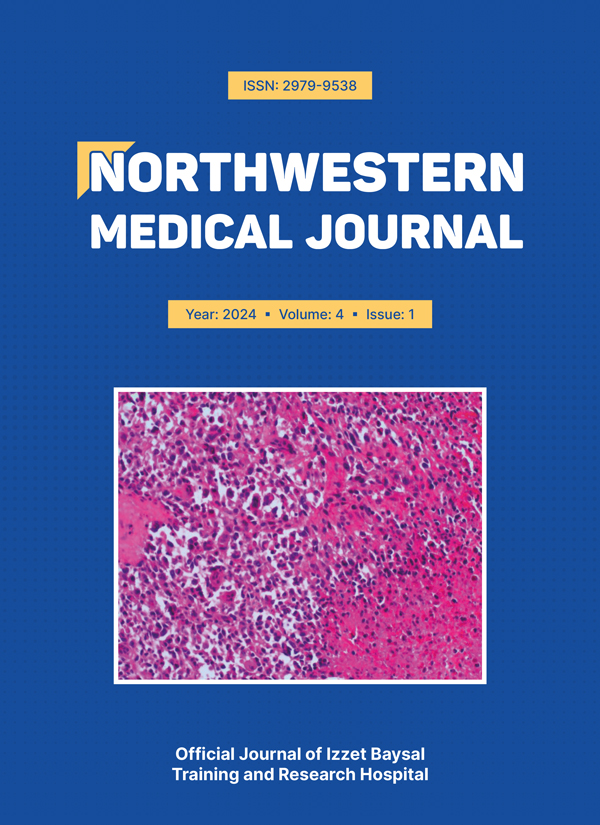Abstract
Aim: Coronary artery disease (CAD) is a common manifestation of cardiovascular disease (CVD). The identification of reliable biomarkers for early CAD detection and risk assessment is crucial for effective prevention and management. This article examines the correlation between the uric acid to HDL cholesterol ratio (UHR) and the total calcium score (TCS) obtained from coronary CT angiography (CCTA) in the assessment of CAD.
Methods: The study included 60 patients (34 males and 26 females) without endocrine diseases or relevant medications to ensure a homogeneous population. Blood samples collected after an eight hour overnight fasting were analyzed for laboratory parameters. CCTA was performed using a standardized protocol. The total calcium score was calculated using established methods.
Results: The analysis showed a significant positive correlation between UHR and TCS (r=0.479, P=0.0001). Patients with coronary artery plaque had significantly higher UHR values compared to those without it (p = 0.001).
Conclusion: These findings suggest that UHR could serve as a promising biomarker for predicting CAD presence and severity, although further research is necessary to validate its clinical utility in CAD diagnosis and management.
Keywords: coronary artery disease, total calcium score, uric acid to HDL cholesterol ratio
Copyright and license
Copyright © 2024 The Author(s). This is an open-access article published by Bolu İzzet Baysal Training and Research Hospital under the terms of the Creative Commons Attribution License (CC BY) which permits unrestricted use, distribution, and reproduction in any medium or format, provided the original work is properly cited.
How to cite
References
- McCullough PA. Coronary artery disease. Clin J Am Soc Nephrol. 2007; 2(3): 611-6. https://doi.org/10.2215/CJN.03871106
- Worthley SG, Osende JI, Helft G, Badimon JJ, Fuster V. Coronary artery disease: pathogenesis and acute coronary syndromes. Mt Sinai J Med. 2001; 68(3): 167-81.
- Voudris KV, Chanin J, Feldman DN, Charitakis K. Novel Inflammatory Biomarkers in Coronary Artery Disease: Potential Therapeutic Approaches. Curr Med Chem. 2015; 22(22): 2680-9. https://doi.org/10.2174/0929867322666150420124427
- Pressman GS, Crudu V, Parameswaran-Chandrika A, Romero-Corral A, Purushottam B, Figueredo VM. Can total cardiac calcium predict the coronary calcium score?. Int J Cardiol. 2011; 146(2): 202-6. https://doi.org/10.1016/j.ijcard.2009.06.057
- Mitsutake R, Niimura H, Miura SI, et al. Clinical significance of the coronary calcification score by multidetector row computed tomography for the evaluation of coronary stenosis in Japanese patients. Circ J. 2006; 70(9): 1122-7. https://doi.org/10.1253/circj.70.1122
- Divakaran S, Cheezum MK, Hulten EA, et al. Use of cardiac CT and calcium scoring for detecting coronary plaque: implications on prognosis and patient management. Br J Radiol. 2015; 88(1046): 20140594. https://doi.org/10.1259/bjr.20140594
- Aktas G, Kocak MZ, Bilgin S, Atak BM, Duman TT, Kurtkulagi O. Uric acid to HDL cholesterol ratio is a strong predictor of diabetic control in men with type 2 diabetes mellitus. Aging Male. 2020; 23(5): 1098-102. https://doi.org/10.1080/13685538.2019.1678126
- Kocak MZ, Aktas G, Erkus E, Sincer I, Atak B, Duman T. Serum uric acid to HDL-cholesterol ratio is a strong predictor of metabolic syndrome in type 2 diabetes mellitus. Rev Assoc Med Bras (1992). 2019; 65(1): 9-15. https://doi.org/10.1590/1806-9282.65.1.9
- Shiga Y, Tashiro K, Miura E, et al. Association Between Major Adverse Cardiovascular Events and the Gensini Score or Coronary Artery Calcification Score in Hypertensive Patients Who Have Undergone Coronary Computed Tomography Angiography. Cardiol Res. 2023; 14(2): 91-6. https://doi.org/10.14740/cr1453
- Nakamura A, Miura SI, Shiga Y, et al. Is pentraxin 3 a biomarker, a player, or both in the context of coronary atherosclerosis and metabolic factors? Heart Vessels. 2015; 30(6): 752-61. https://doi.org/10.1007/s00380-014-0553-0
- Mitsutake R, Miura SI, Shiga Y, Uehara Y, Saku K. Association between hypertension and coronary artery disease as assessed by coronary computed tomography. J Clin Hypertens (Greenwich). 2011; 13(3): 198-204. https://doi.org/10.1111/j.1751-7176.2010.00412.x
- Aktas G, Khalid A, Kurtkulagi O, et al. Poorly controlled hypertension is associated with elevated serum uric acid to HDL-cholesterol ratio: a cross-sectional cohort study. Postgrad Med. 2022; 134(3): 297-302. https://doi.org/10.1080/00325481.2022.2039007
- Yazdi F, Baghaei MH, Baniasad A, Naghibzadeh-Tahami A, Najafipour H, Gozashti MH. Investigating the relationship between serum uric acid to high-density lipoprotein ratio and metabolic syndrome. Endocrinol Diabetes Metab. 2022; 5(1): e00311. https://doi.org/10.1002/edm2.311
- Kurtar Mansiroglu A, Cekici Y, Sincer I, Gunes Y. Serum uric acid and uric acid to HDL-cholesterol ratio in coronary artery fistulas. Annals of Medical Research. 2021; 26(12): 2771-5. https://doi.org/10.5455/annalsmedres.2019.08.479
- Kaya EB, Yorgun H, Canpolat U, et al. Serum uric acid levels predict the severity and morphology of coronary atherosclerosis detected by multidetector computed tomography. Atherosclerosis. 2010; 213(1): 178-83. https://doi.org/10.1016/j.atherosclerosis.2010.08.077
- Li F, Zhao D, Li Q, Lin X, Sun H, Fan Q. Uric Acid to High-Density Lipoprotein Cholesterol Ratio is a Novel Marker to Predict Functionally Significant Coronary Artery Stenosis. J Interv Cardiol. 2022; 2022: 9057832. https://doi.org/10.1155/2022/9057832
- Saito Y, Tanaka A, Node K, Kobayashi Y. Uric acid and cardiovascular disease: A clinical review. J Cardiol. 2021; 78(1): 51-7. https://doi.org/10.1016/j.jjcc.2020.12.013
- Yu W, Cheng JD. Uric Acid and Cardiovascular Disease: An Update From Molecular Mechanism to Clinical Perspective. Front Pharmacol. 2020; 11: 582680. https://doi.org/10.3389/fphar.2020.582680
- Kanbay M, Segal M, Afsar B, Kang DH, Rodriguez-Iturbe B, Johnson RJ. The role of uric acid in the pathogenesis of human cardiovascular disease. Heart. 2013; 99(11): 759-66. https://doi.org/10.1136/heartjnl-2012-302535
- Krishnan E, Sokolove J. Uric acid in heart disease: a new C-reactive protein? Curr Opin Rheumatol. 2011; 23(2): 174-7. https://doi.org/10.1097/BOR.0b013e3283432dd3
- Shah N, Parikh V, Patel N, et al. Neutrophil lymphocyte ratio significantly improves the Framingham risk score in prediction of coronary heart disease mortality: insights from the National Health and Nutrition Examination Survey-III. Int J Cardiol. 2014; 171(3): 390-7. https://doi.org/10.1016/j.ijcard.2013.12.019
- Afari ME, Bhat T. Neutrophil to lymphocyte ratio (NLR) and cardiovascular diseases: an update. Expert Rev Cardiovasc Ther. 2016; 14(5): 573-7. https://doi.org/10.1586/14779072.2016.1154788
- Erdoğan M, Erdöl MA, Öztürk S, Durmaz T. Systemic immune-inflammation index is a novel marker to predict functionally significant coronary artery stenosis. Biomark Med. 2020; 14(16): 1553-1561. https://doi.org/10.2217/bmm-2020-0274
- Elsadek Seaoud EAM, Amin MI, Abdelbasit MS. Total cholesterol/high-density lipoprotein cholesterol and low-density lipoprotein cholesterol/high-density lipoprotein cholesterol as predictors of coronary artery calcification assessed by multidetector computed tomography coronary angiography. ARYA Atheroscler. 2022; 18(2): 1-7. https://doi.org/10.48305/arya.v18i0.2306











